Hair Transplants are a permanent, natural solution for your hair loss
Of all the male cosmetic procedures performed, a hair transplant is one of the more popular cosmetic procedures today. Amongst all cosmetic procedures for men, hair surgery has the potential to produce the most dramatic change in one's appearance.
The new methods of follicular unit transplantation produce some wonderful and dramatic results. It would be almost impossible to detect a good hair transplant, provided a competent surgeon and hair transplant team (hair transplantation is very team-dependant) carried out the work. Your choice of a qualified hair transplant team is very vital to your surgery's success. Under a skilled surgeon, the nightmares that used to be associated with hair transplants have virtually gone, and by using smaller follicular unit grafts with microsurgery, hair transplants offer a very realistic solution to a new head of hair.
Choosing to have hair restoration surgery is a major decision for most people. Hair Restoration Surgery can permanently change your appearance to a more youthful look. A balding man rarely conjures up the image of youth and vitality and that is what most modern men are striving for today. For men who have not lost their hair, this information will be of little value. But for those men suffering from hair loss who want their hair restored, Hair Restoration Surgery is the only permanent solution available for men today. Hair Restoration Surgery will restore hair that will grow naturally and require styling and haircuts, just like men who do not suffer from hair loss.
The first consultation with your hair restoration surgeon is critical to success. A frank and honest discussion of goals, expectations and treatment plans goes a long ways to achieving satisfying results. It helps to meet with the actual surgeon and his team members prior to the surgery. If your first consultation is a commission-driven salesperson (and not your actual surgeon) who gets paid by the number of grafts that your surgery entails, beware, this may not be in your best interest. Always ask for the doctor's credentials and ask to see lots of before and after pictures of previous patients.
Hair transplantation is an operation, which takes hair from the back of the head and moves it to the area of hair loss. The fringe (back and sides) of hair on a balding scalp is known as donor hair which is the hair that will continue to grow throughout the life of most men (this hair is more resistant to falling out due to testosterone and that's the hair from which the grafts are harvested). The transplantation of this resistant hair to a bald area does not change its ability to grow. Dr. Norman Orentreich published the first widely read report on hair transplantation surgery in 1959 and the field of HRS was born. The size of transplants have decreased in size over the last forty years and now the present day controversies hinge upon graft sizes and follicular hair transplants.
Candidates for HRS are those individuals with hair loss that have sufficient donor hair from the fringe of the scalp to transplant to the balding area. In the past, many bald patients were not suitable candidates for HRS but modern techniques have advanced the art of HRS so that many more men are candidates.
Hair transplantation surgery has improved in leaps and bounds over the past decade. The days of the "plugs and corn rows" are gone and the age of blended follicular hair transplant grafting has arrived (ask Dr. Gupta and Susan what this means at the time of your consultation). Through the use of the these variable sized follicular unit hair grafts along with new and improved instrumentation, the accomplished hair transplantation surgeons can create a natural hair appearance that is appropriate and tailor-made or designed for each individual patient. Single follicular unit hair-grafts have the finest and softest appearance. Although they do not provide much density, they do provide the critical soft hairline that is the transition to thicker hair. Reconstructing a new hairline is a skill requiring good surgical technique as well as an artistic eye. It is critically important to get it done right the first time and thus requires considerable forethought and planning. Examining the hairline of a nonbalding person will show the presence of numerous single hairs in the very frontal hairline. Micrografts are small grafts containing 2-3 hairs that are placed behind the hairline to provide a gradually increasing hair density. Lastly, minigrafts contain 4 or more hairs are placed well behind the hairline so that the single hair and micrografts can blend naturally into the density provided by these larger grafts. During our consultations, we take the time to show our patients lots of before and after pictures. Our belief is "a well-educated consumer is a good customer."
There is different terminology and techniques used by many International Society of Hair Restoration Surgeons (ISHRS) surgeons. This is because ISHRS surgeons are innovators and are on the cutting edge of HRS. New techniques naturally give rise to new terms. Although there are variations in the techniques of individual surgeons, the combination use of these grafting techniques provide the most natural and pleasing results.
The side-effects of hair transplantation surgery are relatively minor consisting of mild pain and discomfort after the operation, swelling which may move down to the eyes, and the formation of scabs over the grafts which take approximately one week to resolve. Some complications, however rare, can occur. These include bleeding, scarring, numbness on the back of the head over the donor site and infections. Modern hair transplantation surgery is comfortable, predictable, and the results are pleasing to most patients. The down time after surgery commonly can be anywhere from 1 to 3 days. Ask your consultant to elaborate on this at the time of your consultation.
We cater to cowards and are very sensitive to ensuring that our patients are comfortable during the entire surgical procedure.
Hair loss, however, is a life long process, most men will develop male pattern baldness (due to male hormones) until approximately 40-45 years of age. After that, the aging process thins the entire head of hair. Progressive hair loss or the desire for more density, may require more transplant procedures. Modern techniques, however, allow HRS specialists of transplant larger number of grafts, greatly reducing the number of procedures needed to complete the result.
Before and After

Before - 2012

After - 2018

Before
